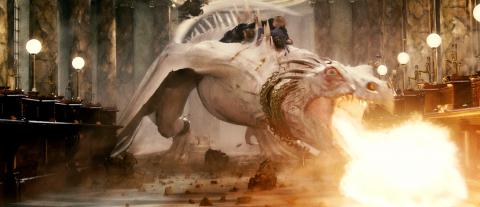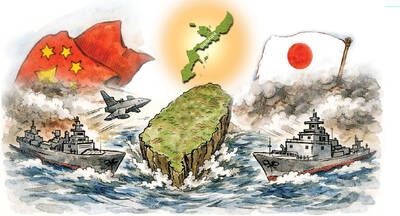It was a remarkably satisfying conclusion to the Potter franchise earlier this week at a 3D press screening at the Showtime Cinema on Linsen North Road in Taipei, but the excitement among the crowd of media and movie industry workers was considerably more muted than the very palpable anticipation of the much more massive crowds that were present for the first screening of Transformers: Dark of the Moon last month.
As has been pointed out more than once, those invested in the Harry Potter series will not want to miss this final installment, but given the serpentine intricacy of a plot developed over eight long feature films, those who aren’t probably couldn’t care less. The release in 3D for this last installment was an unnecessary piece of froufrou that was wholly inadequate to capture the interest of those whose only interest is in witnessing the latest cinematic spectacle.
So, disposing of the 3D issue, for anyone who has given the Harry Potter series any attention over the past decade, the finale has everything that one might hope for. It is conceived on an epic scale, and climbs on the shoulders of the more pedestrian and difficult Deathly Hallows: Part 1, drawing the story to a conclusion that is suffused with melancholy. Many characters who played major roles in previous films are given cameos, almost as if taking their curtain call, and many details of the plot are explained.

Photos courtesy of Warner Bros Entertainment
With its wealth of detail and picking up themes from many of the earlier installments, this final chapter is likely to get many people returning to the series to follow it through once again from the beginning.
The film is unabashed about leaving behind anyone who hasn’t boned up on their Harry Potter lore, diving into the complex endgame of the story with a minimum of preamble. This has been the policy of David Yates since he took over with the fifth Potter movie (Harry Potter and the Order of the Phoenix in 2007), and on the whole it has paid off, giving him more time to craft an appearance of depth and body to J.K. Rowling’s convoluted mythologizing. For newcomers, it makes the film all but incomprehensible. It must be said, that with its oodles of Gothic atmosphere, high melodrama and some clever effects, the film provides a visual feast that helps carry the audience along even when aspects of the narrative may be far from clear.
The three main characters, Daniel Radcliffe (Harry Potter), Rupert Grint (Ron Weasley), Emma Watson (Hermione Granger), for all the hype that surrounds them, have been given parts that are underwritten, and Potter’s charisma is not particularly evident in Radcliffe’s rather shuffling performance. There are, of course, the romantic resolutions, and the big kissing scene between Potter and Ginny Weasley (Bonnie Wright), and also that between Ron and Hermione, seem unearned and cheesy. Yates is better with the dark side of the conflict, and doesn’t shy away from showing the death of much-loved characters as the cost of victory.

Photos courtesy of Warner Bros Entertainment
A few cameos put the still immature talent of the stars in a startling and not particularly welcome perspective. An early scene with John Hurt as Ollivander, the maker of wizarding wands, provides some exposition about the importance of a certain magical artifact. It is a rather thankless role that Hurt manages with superb conviction, and even playing a shriveled old man, his screen presence overwhelms Radcliffe’s heroic efforts. It is splendid to see Maggie Smith letting her hair down as a re-invigorated professor Minerva McGonagall, but other fine actors, Ciaran Hinds and Kelly Macdonald in particular, are little better than extras.
Yates manages the pace of the film extremely well, and the denouement comes as a relief after the painful and sluggish buildup in Deathly Hallows: Part I. There are numerous loose ends, but this doesn’t matter all that much, for Yates has got fully to grips with the main points of the narrative, and barrels ahead, hardly leaving his audience time to catch breath. On the other hand, the set is full of little nuances that will keep Potter fans involved for repeated viewings, delighting in spotting some nice little detail here and there, and acknowledging that the director, for all his determination to bring the big show to a rousing close, has not ignored the finer points of the story.

Most heroes are remembered for the battles they fought. Taiwan’s Black Bat Squadron is remembered for flying into Chinese airspace 838 times between 1953 and 1967, and for the 148 men whose sacrifice bought the intelligence that kept Taiwan secure. Two-thirds of the squadron died carrying out missions most people wouldn’t learn about for another 40 years. The squadron lost 15 aircraft and 148 crew members over those 14 years, making it the deadliest unit in Taiwan’s military history by casualty rate. They flew at night, often at low altitudes, straight into some of the most heavily defended airspace in Asia.

Taiwan’s democracy is at risk. Be very alarmed. This is not a drill. The current constitutional crisis progressed slowly, then suddenly. Political tensions, partisan hostility and emotions are all running high right when cool heads and calm negotiation are most needed. Oxford defines brinkmanship as: “The art or practice of pursuing a dangerous policy to the limits of safety before stopping, especially in politics.” It says the term comes from a quote from a 1956 Cold War interview with then-American Secretary of State John Foster Dulles, when he said: ‘The ability to get to the verge without getting into the war is

Like much in the world today, theater has experienced major disruptions over the six years since COVID-19. The pandemic, the war in Ukraine and social media have created a new normal of geopolitical and information uncertainty, and the performing arts are not immune to these effects. “Ten years ago people wanted to come to the theater to engage with important issues, but now the Internet allows them to engage with those issues powerfully and immediately,” said Faith Tan, programming director of the Esplanade in Singapore, speaking last week in Japan. “One reaction to unpredictability has been a renewed emphasis on

Beijing’s ironic, abusive tantrums aimed at Japan since Japanese Prime Minister Sanae Takaichi publicly stated that a Taiwan contingency would be an existential crisis for Japan, have revealed for all the world to see that the People’s Republic of China (PRC) lusts after Okinawa. We all owe Takaichi a debt of thanks for getting the PRC to make that public. The PRC and its netizens, taking their cue from the Chinese Communist Party (CCP), are presenting Okinawa by mirroring the claims about Taiwan. Official PRC propaganda organs began to wax lyrical about Okinawa’s “unsettled status” beginning last month. A Global